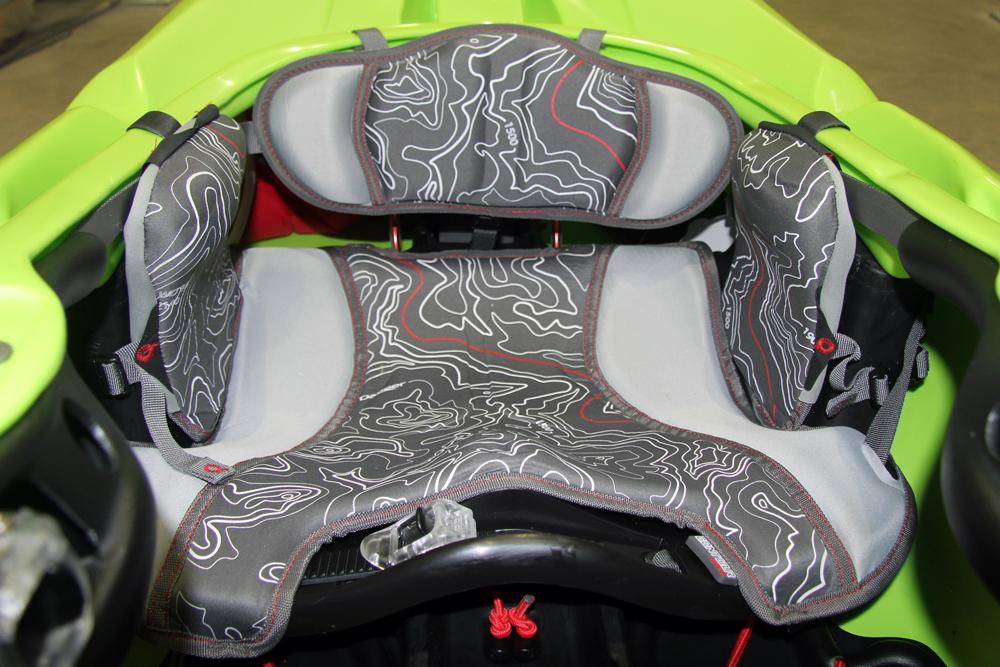Three things you should do to every whitewater boat.
1 – Airbags keep your boat afloat
Water is a kilo per litre, so two thirty litre airbags in your boat means about sixty kilos less boat to rescue!

We’re all between swims – airbags will help minimise the damage
Airbags provide vital extra buoyancy should your boat end up in the water without you. Airbags should be tied in (to your seat) and fit snugly (we make a whole family of sizes to help with that). If you, like me, have short legs and lots of space in front of your footrest, consider putting airbags up front too. Even with only a small space in front of your footrest you might be able to squeeze in a partially deflated kids plastic football. Every kilo counts and buoyancy in your bow will help.
The Heavy Weight float bag family from Palm
Palm’s range of airbags fit perfectly inside modern whitewater kayaks. The dimensions of our 30 litre float bag have been adjusted to fit snugly in today’s larger creek boats like the Mamba 8.6. The 15 litre float bag has been updated to better suit the stern space of modern playboats like the Jitsu. The 25 litre float bag is still our longest float bag, which is great for old school and longer boats like the Green. We’ve added dump valves to the 30 and 25 litre bags, so that you can deflate and pack away these larger float bags much more easily.
To prolong the life of your float bags: First, take them out of your boat occassionally to let them dry and to clear any sand, grit and river detritus that has built up in the bilges of your kayak. Second, don’t leave them permanently fully inflated. Let a little air out before you put your kayak away, and top them up with a couple of breaths when you’re about to go paddling, that way they will not be under constant pressure, and should they warm up in the sun, they won’t be over stretched.
2 – Set up your cockpit
First, set your seat position, this usually means having your centre of gravity at the kayak’s mid point (or centre of floatation). Too far forward and your nose will tend to catch and bury itself, too far back and the tail will become catchy and your nose will ride way up in the air when surfing. As a rough guide, when floating on flat water in an upright position, your kayak’s nose and tail should be about the same distance from the water.
Up, down, forward backwards – take take the time to get this right.
The height of your seat also changes things drastically with only a few centimetres difference. Extra height will give you more forward reach and more leverage, but balance will feel a little twitchier. To increase your seat height, insert a layer or two of foam under your seat pad. Dagger’s Contour Ergo system also features a leg lifter strap to support your thighs and get that rally driver’s bucket seat feel.
With you seat positioned, it’s time to set up your hip pads, thigh grips, and backrest. Good points of contact with your kayak will help you to control your boat at extreme angles and should hold you firmly in place whether upside down, on your side, or bouncing between the two. Hip pads, thigh grips, and backrest should be supportive, but you’ll know it’s too tight if you start to get pins and needles. In my opinion, the Dagger hip pad kit is the best there is, with two retaining straps and velcro backing, it’s an easy addition to improve any make or model of kayak.
Small changes to your backrest setup can also have a marked effect, especially for longer days out. Your backband should be supportive and stiff, without causing discomfort. It should promote your upright, slightly forward, active paddling position, and sit low on your back so it doesn’t immobilise your spine (can you still lean against the back deck or rotate your torso fully?). Loosening the upper cockpit rim straps and tightening the lower strap that holds the backband to the seat will help keep your backband low and also prevent that unfortunate ass-pinch! Most modern backrests come with adjustable ratchet systems, but if not you can often retrofit one. The Dagger Freestyle Backband is simple, strong and another simple upgrade to any make or model of kayak.
Hips, back and bum – padded, but still firmly supported.
3 – Pad your footrest
For effective forward paddling, a good footrest is vital. Creek boats should have a full plate footrest which ensures there are no gaps for your feet to slip through, and plenty of foam padding to cushion you from full-on frontal crashes. Our playboats come with stackable foam blocks, which are really easy to adjust.
A full plate footrest should leave no gaps for your feet to slip through
Ideally your footrest should be angled to support your heels as well as the ball of your foot. It’s a good idea to add small foam wedges for your heels to rest on. Even if you have big feet, very little room in the bow, or inflexible ankles, adding heel blocks can help to reposition your feet to make paddling a whole lot more comfortable.

Dagger’s Creek and River spec expanding foot cups make adjusting your foot plate a breeze
Take some time to get these three things right and your time on the water will be safer, comfier, and much more fun. Now I’m all set for some winter paddling, let’s hope for a rainy one. See you on the water!
PS Don’t expect any help rescuing your boat if it doesn’t have airbags.
PPS This is all much more effective if you don’t cut big holes in your kayak beforehand.





